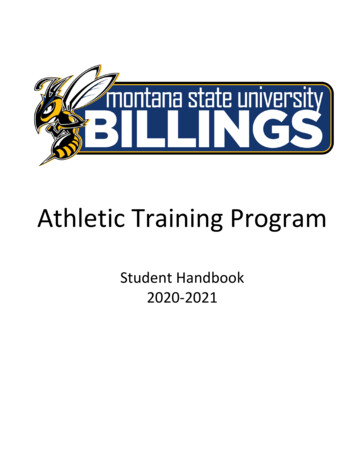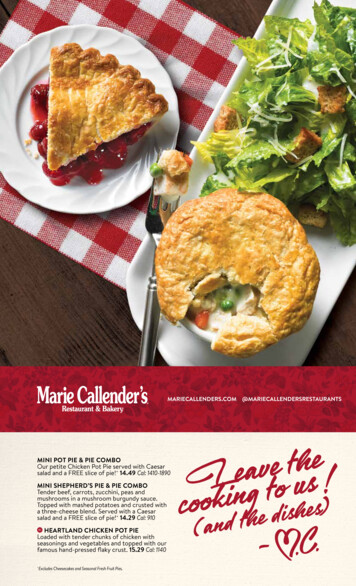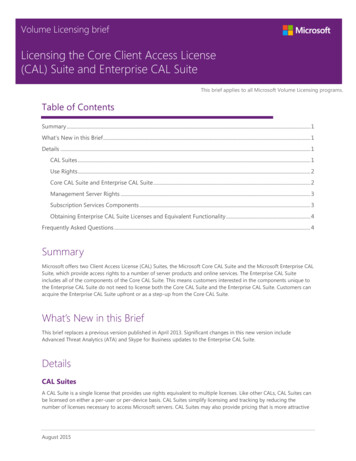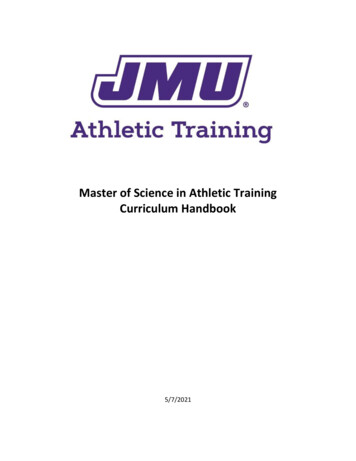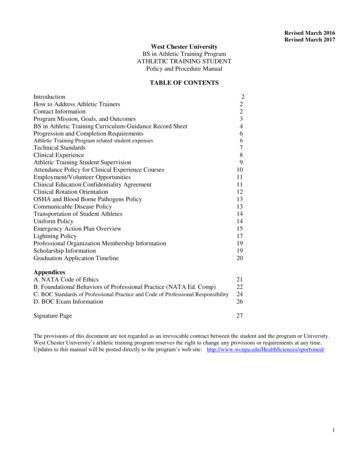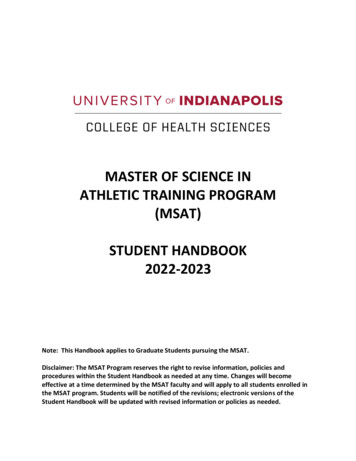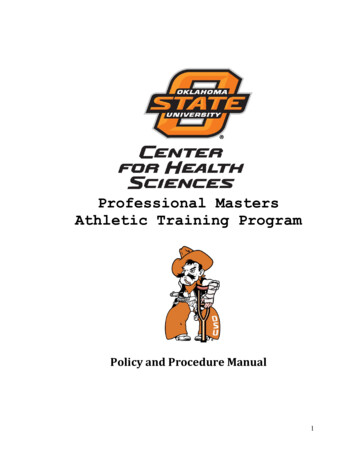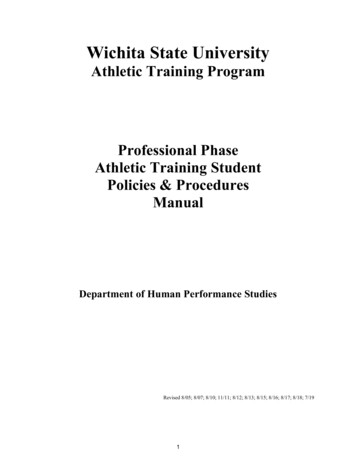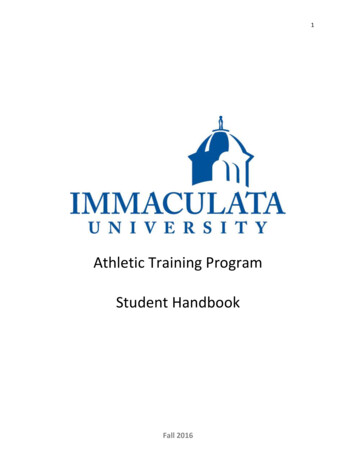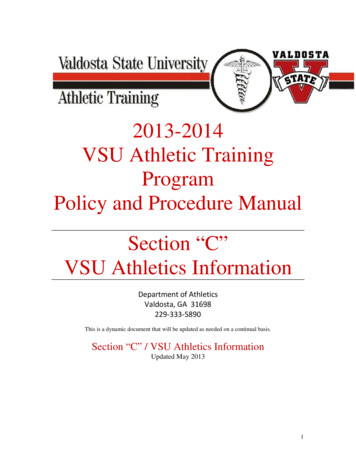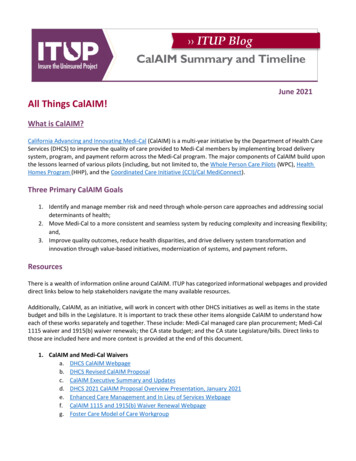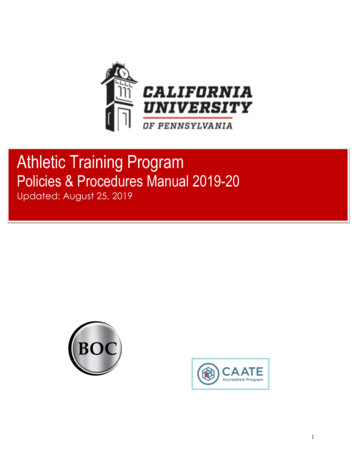
Transcription
Athletic Training ProgramPolicies & Procedures Manual 2019-20Updated: August 25, 20191
Program Directory . .3I. Program Mission . .4II. Distance Education .5III. Student Code of Conduct.6IV. Program Admissions.7V. Academic Program .8Academic Standards . .10Scheduling and Advising .10Students with Disabilities .10VI. Student Program Binders 10VII Additional Program Expenses . .11VIII. Awards and Scholarships . . .11IX. Program Meetings . . .13X. Additional Expectations . . .14XI. Clinical Education . 15Clinical Assignments 15Emergency Action Plans . .17OSHA & Bloodborne Pathogens Training .17Communicable Diseases . 17Travel . .18Confidentiality 19Dress Code . .16Attendance .17Extracurricular Activities . .19XII. Interpersonal Relationships .19XIII. Grievances . . 20AppendicesAppendixA . Error!Bookmark not defined.Appendix B . .23Appendix C . .25Appendix D . .26Appendix E . .29Appendix F . .30Appendix G .31Appendix H . .322
Program DirectoryNameShelly DiCesaro, PhD, LATMindi Fisher, DAT, ATJeff Giovannucci, MS, ATShane HennessyKayla Shinew, PhD, AT, ROTJamie Weary, PT, ATJordan Blair, MS, ATMercedes Himmons, MS, ATJimmy Hoover, MS, ATScott Zema, MEd, ATAthletic Training Program FacultyClinical Site/TitleEmail AddressChair, Department of Health Sciencedicesaro@calu.eduClinical Education CoordinatorInstructorfisher@calu.eduMen’s SoccerInstructorgiovannucci@calu.eduTrack & Field and Cross CountryMedical Directorhennessy885@gmail.comProgram Directorshinew@calu.eduAssociate Professorweary@calu.eduCalU Clinical Athletic Training FacultyAssistant Athletic Trainerblair j@calu.eduVolleyballMen’s BasketballSoftballAssistant Athletic Trainerhimmons@calu.eduWomen’s SoccerWomen’s BasketballAssistant Athletic Trainerhoover j@calu.eduFootballBaseballHead Athletic Trainerzema@calu.eduFootballGraduate Assistant Athletic TrainersNumberO: 724-938-5831O: 724-938-4638O: 724-938-4011412-327-4433O: 724-968-4823C: 814-233-9197O: 724-938-5708O: 724-938-4562O: 724-938-5731O: 724-938-4332O: 724-938-4562C: 724-884-5104Sean Adams, ATSam Debias, MS, ATJoe Graceffo, MS, ATJennifer Kostik-Johnson, DPT, ATCMike Lesako, MS, ATSarah Pappapietro, MS, ATThamar Perry, MS, ATAffiliated Clinical Sites: PreceptorsCalifornia High SchoolUpper Saint Clair High SchoolNovaCare Physical TherapyW&J CollegeTJ High SchoolRinggold High School3
I. Program MissionThe mission of the Professional Athletic Training Program is in keeping with the College and University mission of“building the character and career of students” by educating clinically competent, entry level athletic trainers who arecapable of serving the community in a variety of employment settings. To prepare entry-level athletic trainers, theprogram has developed a comprehensive curriculum that encompasses didactic and clinical instruction with a specialemphasis on the use of technology in the daily practice of athletic training (in keeping with the University’s specialmission in technology). In addition, the program strives to produce entry level athletic trainers that exhibit theprofessionalism and the University’s core values of integrity, civility and responsibility, appreciate continuingeducation and are academic consumers of research. Finally, the program upholds the above tenants of its missionthrough engaging in and delivering didactic content and clinical experiences reflective of best practices throughevidence-based findings.Program Outcomes & Objectives1.2.3.4.5.Program graduates will be prepared to sit for and pass the BOC Exam.Program graduates will be adept at using technology in the delivery of athletic training services.Program graduates will appreciate the importance of continuing education.Program graduates will be able to interpret and utilize research in the delivery of athletic training services.Program graduates will be prepared to make patient care decisions based on the domains of athletictraining.6. Program graduates will be prepared to practice as an athletic trainer in a professional and ethical manner asoutlined in the NATA and BOC code of ethics.7. Prepare students to enter an entry-level athletic training position in a variety of employment settings.Program ObjectivesStudents will be able to:1. demonstrate foundational behaviors of professional practice in athletic training as defined by the NATACompetencies.2. understand evidence-based practice concepts in athletic training.3. demonstrate knowledge and skills in all educational competency areas.4. have knowledge in professional development and responsibility of the entry level athletic trainer according tostate and national regulations.5. demonstrate proficiency in clinical skills and knowledge consistent with their academic level.6. identify their own personal and professional deficiencies and strengths prior to registering for the BOCExam.7. demonstrate use of technology used for preventing, evaluating, treating, diagnosing, and managingorthopedic and general medical pathologies.8. apply clinical skills on actual patients that provide progressive amounts of supervised autonomy duringclinical assignments.9. perform skills in a clinical environment that is conducive to learning.4
II. Distance EducationCalifornia University of Pennsylvania and Clarion University collaborate academic and clinical components of theathletic training program through a distance education model. This model allows students who are enrolled at ClarionUniversity to be a part of California University of Pennsylvania’s Athletic Training Program. Students in the distanceeducation program must be enrolled at California University of Pennsylvania beginning the second year in theprogram. This contract has expired and the program will teach out the remaining cohort; Class of 2020.Degree: The degree of Bachelor of Science in athletic training is granted from California University uponsuccessful completion of the athletic training program and general education courses required by theuniversity.Curriculum: Students enrolled in the distance education program follow the same curricular outline (seeAcademics section)Coursework: Classes are taught primarily by CalU faculty via iTV (live feed). There are a few athletic trainingclasses that are taught by faculty at Clarion University. Credits taken at Clarion University (including GeneralEducation courses) may be transferred to California University of Pennsylvania to count towards the degree.Contact the Office of Articulation and Transfer for assistance in transferring credits.Clinical experience: All clinical experiences for students at Clarion University are located at ClarionUniversity or other local affiliated site. Refer to the Clinical Education section of this manual for other clinicalrequirements.Communication: Students need to set up their CalU email addresses to be forwarded to their Clarion emailaccounts. All email communication with faculty, preceptors, etc, must come from your Clarion or CalU emailaccounts.Clarion distance education students are held to the same standards and expectations as stated in this Policies &Procedures Manual.5
III. Student Code of ConductStudents are expected to conduct themselves in a professional manner at all times. Honesty and respect towardsfellow students, patients, coaches, preceptors, athletic trainers, physicians, athletic department personnel, officials,and faculty must be demonstrated at all times. Unprofessional conduct will not be tolerated. Violation of the AthleticTraining Code of Conduct will result in disciplinary action. Students must follow the policies and proceduresdescribed in this document and abide by the Pennsylvania State Medical Board Bylaws, the NATA Code of Ethics(regardless of membership status), the BOC’s Standards of Professional Practice, and adhere to CalU’s StudentCode of Conduct.Students must download, read, and save the following documents, which are considered a part of this manual:California Academic Integrity Policy: https://www.calu.edu/inside/policies/ vania State Practice Act bchapHtoc.htmlNATA Code of Ethics http://www.nata.org/codeofethicsBOC Standards of Professional Practice http://www.bocatc.org/system/document cipline CodeFailure to comply with the Code of Conduct and/or policies described in this document will result in one of thefollowing disciplinary actions at the discretion of the Program Director and/or University Legal Council. Theseinfractions will become part of your permanent record.Missed clinical assignment or tardiness without prior notification and approval of the preceptor:1st offense: Policy Violation Form from the Clinical Education Coordinator (see Appendix A)2nd & Subsequent Offenses: written notification from the Program Director of the athletic training student beingplaced on disciplinary probation.Dress code violation:1st offense: verbal warning from the preceptor2nd offense: Policy Violation Form giving a written warning from the Clinical Education Coordinator3rd & Subsequent offenses: written notification from the Program Director of the athletic training student beingplaced on disciplinary probation.Drug and Alcohol Policy Violation1st offense: immediately placed on Disciplinary Probation; the student must undergo on-campus (or other approved)drug and alcohol prevention/awareness education program. Failure to attend or comply is means for dismissal fromthe AT Program.2nd Offense: dismissal from AT Program and referral to on-campus or other approved drug and alcoholprevention/awareness education program.Academic ProbationStudent enrolled in the program are required to maintain a combined 3.00 GPA in their required AT and relatedcourses and a 2.75 cumulative GPA. Passing each AT or related course with a minimum of a “B-” or better. Anystudent that falls below this minimum will be placed on a one semester probationary period. The student will be senta letter regarding the probationary status, which will outline what measures the student must take in order to return togood standing. Depending on the course, the program director will make discretionary decisions regarding the6
student’s ability to progress on in the curriculum (ie multiple course deficiencies or a course within a sequence).Failure to remedy the deficiency, will automatically be dismissed from the program. If a student is dismissed from theprogram, they must attain minimum academic program standards to be eligible to reapply to the professional phaseof the program. The student should contact the Program Director to discuss readmission criteria.Note: If a student is placed on probation due to a grade lower than a “B-”, the student must retake thatcourse in order to be eligible for graduation. A student cannot graduate with a grade lower than a “B-” in anyAT Program related course.Disciplinary ProbationThis probation category pertains to students who been found guilty of having had difficulty with, but not limited to,unprofessionalism or unethical behaviors, inadequate time commitment, cheating, or other academic dishonesty,stealing, disrespectful behavior toward faculty, staff, or fellow students, misrepresentation of oneself in theprofession, or disregard for the program’s policies.If a problem arises in any one of these areas, the student will be asked to schedule an appointment with the ProgramDirector to discuss the particular situation. The Program Director will identify the problem in writing, what thedeficiencies are, and document any other pertinent information regarding what needs to be done to rectify thesituation. Should the situation(s) not be rectified within two to three weeks (or an acceptable time frame), the athletictraining student will be dismissed from program. If a student is placed on disciplinary probation twice during theprofessional phase, he/she will be dismissed from the program.Conduct that results in felony charges will, at a minimum, warrant disciplinary probation in the program and will beconsistent with California University of Pennsylvania’s policy on such offenses. It is the student’s responsibility tonotify the program director if felony charges occur.IV. Program AdmissionsThe program has admitted our final BSAT cohort. Students interested in pursuing athletic training shoulduse the 3 2 Health Science/Pre-Athletic Training Concentration.Readmission Procedures Following DismissalA student may reapply to the program in the spring following his or her dismissal. The athletic training student will beexpected to meet with the program director prior to submitting the following material: Application Interview with AT faculty Obtain a “B-“ or better in the required AT Program courses Obtain a cumulative GPA of 2.75 or better Provide a 2-page minimum statement reflecting the student’s intent to improve on or change his or hercourse of action that resulted in dismissal from the program. This should include a plan the studentintends to implement to make a positive change, what the experience resulting in dismissal has taughthim or her, as well as how the student will apply what they have learned.See Appendix B for the program Technical Standards and Appendix C for the Hepatitis B Waiver form.7
V. Academic ProgramThe 120 credit program leading to the Bachelor of Science in Athletic Training degree is designed to be completed in4 years (8 semesters). The eight-semester sequence of courses provides a recommended framework for completingthis program of study in four years.8
9
Academic StandardsOnce a student has been admitted into the program, they must then complete the remaining academic requirementsas well as maintain a 3.00 GPA in their athletic training and major coursework on a semester by semester basis. A2.50 overall QPA is required in order to graduate from the College of Education and Human Services.Qualifier ExamIn an effort to instill a sense of accountability, focus, and enable positive progression toward passing the BOC exam,at the end of each academic year, the program will host cumulative qualifier exams for each cohort. A score of 75%or better must be earned in order for the student to progress on to the next year of the program. The exams will bedone electronically (as a BOC preparation/simulation technique) and through the program’s D2L course shell. Ifunsuccessful, students will develop a remediation plan with the program director and have one retake attempt. If theretake is unsuccessful the student will be dismissed from the program.Scheduling and AdvisingAll students who are pursuing an athletic training major will be advised by the Athletic Training faculty. Eachsemester the academic advisement sheet should be updated by the athletic training student and his/her advisor. Thisdocument is to be kept in the student records folder. Scheduling will be in accordance with university policy.When selecting class schedules, students should attempt avoid classes that meet during traditional clinical times.Students with DisabilitiesRequests for approval for reasonable accommodations should be directed to the Office for Students with Disabilities(OSD). Approved accommodations will be recorded on the OSD Accommodation Approval notice and provided tothe student. Students reserve the right to decide when to self-identify and when to request accommodations.Students are expected to adhere to OSD procedures for self-identifying, providing documentation and requestingaccommodations in a timely manner. For assistance, please contact;Office for Students with DisabilitiesCarter Hall, G-35724.938.5781Fax: rrent-students/student-services/disability/VI. Student Program BindersThe program will provide each student a cumulative binder of programmatic documents, patient encounter logs,assessments, clinical hour logs, etc. This will serve 2 primary purposes; to ensure evaluation and proficiency of allrequired content knowledge/skills/abilities and secondly as a portfolio of the student’s work.Skill Check-offsWithin the binder, there are CIP Skill Related Check-offs. This is a two-tiered “check-off” system, peers andpreceptors/instructors will evaluate students’ attainment of the skills associated with the CIPs. CIPs will continue tobe assessed, but each CIP will have associated skill check-offs. The associated check-offs with be assigned to becompleted within each clinical education course (ie CIP-2.F check-off assigned to ATE 204 Clinical Education I).Check-off Scoring Rubrics are provided within the binder and will be turned in to the clinical education courseinstructor, and then stored as a part of the binder.A third check-off will be completed by the clinical education course instructor in evaluating the student on acumulative final practical scenario that is encompassing the assigned check-offs. All assigned skill check-offs andCIPs must be successfully completed in order to pass the clinical education course.10
Patient Encounter LogsPatient Encounter Logs are a way for students to track the clinical skills they have had the opportunity to apply whileat their clinical experiences. This serves as a tracking mechanism and can be used to demonstrate the students’experiences. Logs will be a require component of each Clinical Education course.VII. Additional Program ExpensesThere are additional costs associated with the AT Program. Professional students are required to purchaseprofessional attire to be worn during clinical education experiences. Students assigned to off campus clinical sites willalso incur costs associated with travel to and from the clinical site.One-time Program costsFinger Printing 40Child Abuse Clearance 10Criminal Background Check 10Approximate Yearly CostsProfessional Liability Insurance 15Clothing (approx.) 30-100Off-Campus Travel 50-200 (depending upon the site)NATA Membership 85Professional Development Participation- variedProfessional OrganizationsStudent membership to the NATA is required. A copy of your membership card must be submitted to theprogram director. There are other benefits for students who are members of the NATA including networkingopportunities, NATA News, access to the Career Center and Education Foundation etc.At least once during the professional phase of the program, each student must attend a professionalmeeting/conference at the local, state, or regional level. Local and free opportunities exist as well aspotential financial assistance from the AT Student Organization and program budget.VIII. Awards and ScholarshipsNATA, EATA, and PATS Scholarship AwardsEach year the NATA, EATA, and PATS offer senior students an opportunity to apply for scholarship money forgraduate school. All students are also eligible to apply for scholarships. Each organization requires independentapplications for each candidate. Refer to the respective organization’s website for scholarship opportunities anddeadlines.Most Outstanding Senior Athletic Training StudentAll senior graduates (August, May, and December) are eligible. The faculty use the following five criteria whenmaking the selection. The student with the most votes is awarded the distinction.a. Academicsb. Time commitmentc. Clinical skillsd. Interpersonal skills11
e. Working knowledge of athletic trainingOutstanding Alumni AwardEach year the AT Program Faculty nominate and vote on an Alumni who has excelled in the profession of athletictraining making contributions to the profession befitting of an outstanding professional. Up to one winner is selectedeach year.Cal U Sports Medicine ScholarshipTwo 500 scholarships are awarded annually to one junior and one seniorQualifications: Must be enrolled in the athletic training program Must be in good standing with the program Demonstrate need for financial assistance Scholarships are non-renewed; new recipients awarded each yearSelection: Nominations and selection process will be made by the Athletic Training faculty based on the followingcriteria:o Goes above and beyond during clinical assignmentso Takes advantage of educational opportunitieso Demonstrates strong clinical skills for current level in programo Demonstrates willingness to mentor other athletic training studentso Works well as a team leader and a team player with peerso Demonstrates desire and initiative to pursue clinical profession as career pathDirector of Financial Aid and Head Athletic Trainer will notify the Foundation once a recipient has been selected. TheFoundation will make the final award.For additional financial assistance information, visit the Office of Financial Aid.12
IX. Program MeetingsTraditionally, there is a program meeting scheduled for the evening before classes begin each fall semester. Othermeetings will be scheduled as needed. Program meetings are mandatory.In-service meetings are presented to the program to provide insight into various aspects of the broad field of sportsmedicine. These will be announced in advance and generally scheduled for the evening and/or weekend. In-servicesare mandatory.If you miss an in-service or program meeting you must submit proof of emergency to the Program Director in writingwithin 24 hours of the event. If you miss a program meeting for an unexcused reason, a Policy Violation form will becompleted to document the offense and kept in your permanent student file. You will not be allowed to begin yourclinicals until you have received and reviewed the information presented at the required meetings.Program EngagementInvites to program events (ie social gatherings, club sponsored activities, Cases & Coffee, etc.) are communicated tostudents via email and/or meetings. The goal of these events is to open the lines of communication, share a currenttopic and/or to provide clinical and education pearls. Students’ participation and attendance is strongly encouraged.MentorshipThrough the program’s extensive AT alumni resources, each student will be paired with an alumni mentor currentlyemployed in the profession. This relationship will aid the student in numerous ways offering another avenue forprofessional advice, as well as begin to develop/understand the importance of creating a professional network.13
X. Additional ExpectationsClassroom Attendance and BehaviorInstructors develop their own attendance policies that are communicated through the course syllabus. The programexpects proper and prompt attendance for all scheduled courses. You represent the Professional Athletic TrainingProgram in all of your courses. We expect that you always demonstrate professional integrity, respect, and behavior.Classroom Technology PolicyThe use of cell phones (ie. texting, playing games, Facebook, etc.) during class lecture and laboratory is strictlyprohibited. Students may not record lectures (video or audio) without the instructor’s permission.The use of computers/tablets is permitted during class at the discretion of the instructor. The viewing of nonacademic sites during class or lab time is prohibited.Violation of this policy can result in dismissal from the class, an unexcused absence, and/or a policy violation, at thediscretion of the instructor.Social MediaStudents are expected to continue to maintain patient confidentiality even in the spirit of self-expression throughsocial media. Inappropriate use of social media involving your responsibilities or privileges as an Athletic TrainingStudent will not be tolerated.Please keep in mind everything that you decide to share through social media is public. Although social media is acomponent of your private life, keep in mind that you are still representing our program, the University, and theprofession of athletic training. Many people within our field have access to these online networks and maybe viewedby other professionals and potential employers.If any distasteful means or inappropriate behaviors are displayed or shared through your social media you aresubject to disciplinary action or expulsion from the program at the discretion of the Program Director.Email CommunicationAll email communication with faculty, staff, preceptors etc. must be done through students’ CalU email accounts.Cheating and PlagiarismThe student will be held to the California University of PA Academic Integrity policy (see Appendix D).Professional Performance EvaluationsAs a means to better monitor, give feedback, and force accountability to the students, the program plans toimplement bi-semester evaluation meetings to discuss, individually, student’s clinical, academic, and overallprofessional performance. Prior to the meeting the program director will gather academic performance data fromeach athletic training faculty member using the Professional Performance Evaluation form (see Appendix E). Atmidterms, each student will meet collectively with their preceptor, clinical education/practicum course instructor, andprogram director. Final performance evaluation meetings will be done at the end of each semester in front of thestudent’s preceptor and entire AT Faculty.Remediation PlanEach semester, immediately following midterms, grades and academic performance will be assessed and reported atthe program’s AT Faculty Meetings. Any student who’s grade falls below a ‘B-‘ will be required to complete aremediation plan outlined by the course instructor and program director (see Appendix F).Any student who is placed on programmatic probation, due to an insufficient final course grade in an athletic trainingcourse, will also be required to complete a remediation plan. The plan will be developed with the student, courseinstructor, and program director to devise a strategy for improved academic performance14
XI. Clinical EducationClinical education provides students with opportunities for real patient care while under the direct supervision ofpreceptors (i.e. Athletic Trainer or other credentialed health care professionals). The clinical education coursesequence is designed to provide students with the opportunity to synthesize and apply what is learned in theclassroom and laboratory on a patient population. Through both observation and participation, students will have theopportunity to experience and participate in the practice of athletic training. To different degrees, students will beinvolved in injury prevention, management, and rehabilitation of orthopedic injuries including exposure to generalmedical conditions and emergency care within the clinical sites. Students will have the opportunity to provide healthcare services for practice and game situations and may have the opportunity to travel to away events.The clinical education plan is a dynamic document, allowing the synthesis of didactic and laboratory knowledge/skillsto translate into real life patient care. Clinical education begins early in the student’s career at CalU and continuesuntil graduation. Students receive credit for clinical education in six Athletic Training Clinical Education courses,which are taken in each of the last six semesters (i.e. ATE 204, 206, 305, 306, 405, 406).Clinical AssignmentsSecond year students receive five-week assignments. Third and fourth year students are assigned on a semesterbasis.Students are assigned a variety of clinical experiences, under multiple preceptors, to ensure the best qualityeducational experience. Variety is defined by the CAATE as settings that address the continuum of care with patientsthat participate in a variety of activities. Including, but not limited to: Individual and team sports, equipment intensive,patients of different sexes, physically active but not part of an organized sports team, and exposure to conditions thatare more systemic in nature as opposed to orthopedic.Clinical Education AssessmentsThe following clinical assessments will be conducted:SophomoresEvaluation of Athletic Training Student - after each 5-week rotationClinical Experience Evaluation- performed by students after each rotationClinical Hour LogsJuniors & SeniorsEvaluation of Athletic Training Student - midterm and finalClinical Experience Evaluation- performed by students after each rotationClinical Hour LogsNote: The above evaluations will be counte
4. Program graduates will be able to interpret and utilize research in the delivery of athletic training services. 5. Program graduates will be prepared to make patient care decisions based on the domains of athletic training. 6. Program graduates will be prepared to practice as an athletic trainer in a professional and ethical manner as
